
The previous blog post introduced our 8-day itinerary for traveling in Japan during the autumn foliage season. To cut down on transportation expenses during our trip, we looked into and utilized several passes including the “Kansai Area Pass,” “HARUKA One-Way Ticket,” “Sagano Scenic Railway,” “JR Kansai Mini Pass,” and the “Kyoto Subway & Bus One-Day Pass.”
Over 8 days in Japan’s Kansai region, our actual transportation cost per person was ¥11,620, totaling ¥34,860 for three people. At the exchange rate at the time, this was approximately 1743 RMB. By using the discount passes, we saved ¥1,420 per person, totaling ¥4,260 for three people, which was about 213 RMB at the prevailing exchange rate.
In this article, I will introduce the types of rail transport in Japan, as well as how to book, pick up, and important points to note regarding the tickets and passes we used.
Types of Rail Transport in Japan
Japan’s railways can be broadly categorized into JR, Kintetsu, Private Railways, and Subways.
JR Railways
JR stands for Japan Railways, a large group of railway companies in Japan, formerly known as Japanese National Railways (JNR). JNR was privatized and split into seven companies in 1987 (JNR Division and Privatization). These successor companies are collectively known as “Japan Railways.”
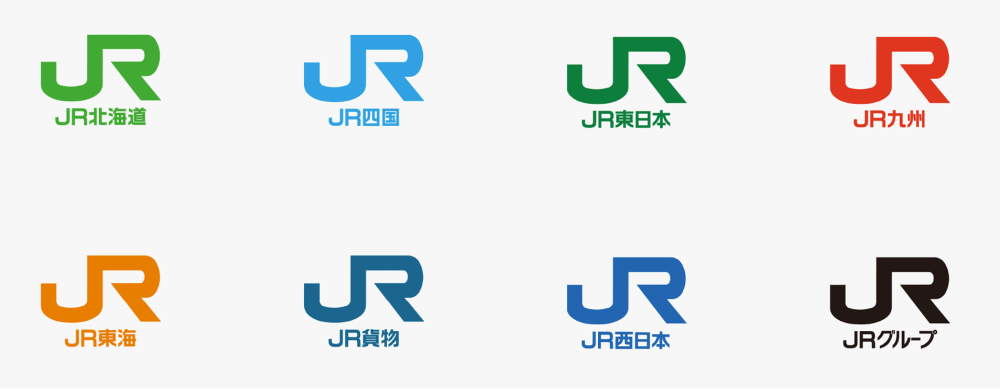
Logos of JR Group Companies
JR lines are divided into “Conventional Lines” (Zairai-sen) and “Shinkansen.” Shinkansen tickets are the most expensive, but the trains are also the fastest, similar to high-speed rail in China. For long distances where time efficiency is crucial, the Shinkansen is a good option. However, tourists visiting Japan typically use JR’s “Conventional Lines” more often for their travels.
Trains running on JR “Conventional Lines” are usually classified as Local (普通), Rapid (快速), Special Rapid (新快速), Express (急行), Limited Express (特急), etc., similar to different speed classifications like local, fast, express, and direct trains in China.
Different service types have different fares. These trains of varying speeds often run on the same tracks and use the same platforms. If you’re not careful, you might buy a “Local” ticket but board an “Express” or “Limited Express” train. If a conductor checks your ticket, you might be asked to pay a supplementary fare or even be asked to leave the train.
Private Railways (私鉄 - Shitetsu)
As the name suggests, these are privately operated railways. Private railways in Japan mainly handle commuter transport within cities or between cities. They can be categorized by scale into major private railways (Ōte Shitetsu), quasi-major private railways (Jun-Ōte Shitetsu), and various small and medium-sized private railways. The major and quasi-major private railways are generally located in major metropolitan areas (Tokyo, Osaka-Kobe-Kyoto, Nagoya, Fukuoka).
Examples relevant to our trip in the Kyoto and Osaka areas include Keihan Electric Railway and Hankyu Railway, both of which are private railways.
Subways (地下鉄 - Chikatetsu)
Similar to subways or metros in other countries, these are underground transportation systems. Subways in Japan are privately operated, unlike in China where they are typically run uniformly by the government. In some Japanese cities, multiple companies operate the subway system! Lines run by different operators are not interconnected; transfers often require exiting the gates of one system and entering another, requiring a separate ticket purchase.
Kintetsu Railway (近鉄)
Kintetsu Corporation (近畿日本鉄道 - Kinki Nippon Tetsudō), commonly known as Kintetsu, operates routes across Osaka, Nara, Kyoto, Mie, Gifu, and Aichi prefectures. With a total operating distance of 582.3 km, it is the largest private railway company in terms of route length and is considered one of the “Big Three” private railways.
Its network can be divided into three main systems: Osaka/Nagoya, Nara/Kyoto, and Minami Osaka. A common example is taking the Kintetsu Nara Line from Osaka to Nara.
Kintetsu is often used for sightseeing. Their train designs can be quite attractive, and you can book seats and even meals online. Some train interiors are luxuriously decorated.
Several JR Discount Passes for the Kansai Region
Since our trip focused on cities within the Kansai region like Osaka, Kyoto, Uji, and Nara, the relevant JR discount passes we researched and booked were found on the JR West Official Website .

JR West Official Website
JR West Rail Pass - Kansai Area Pass
JR West offers many types of rail passes covering different areas; choose one based on your travel plans. Since our travel was limited to Osaka, Kyoto, Uji, and Nara, we focused on the “Kansai Area Pass,” which covers the smallest area among relevant options.

JR West Rail Passes
Taking the “Kansai Area Pass” as an example, this pass allows rides on the “Kansai-Airport Express HARUKA,” as well as Rapid (including Special Rapid) and Local trains within the designated Kansai area. Besides JR lines, the “Kansai Area Pass” also includes vouchers exchangeable for one-day passes on the “Kyoto Municipal Subway,” “Keihan Electric Railway,” and “Hankyu Railway.”
You can book the “Kansai Area Pass” yourself on the “JR West Official Website.” Options for 1 to 4 consecutive days are available. The reservation URL is Kansai Area Pass Reservation .
Note the “Authentication Number” you enter during reservation. Try to choose a 4-digit number you can easily remember, as you’ll need it to collect your tickets, make changes, or get refunds.
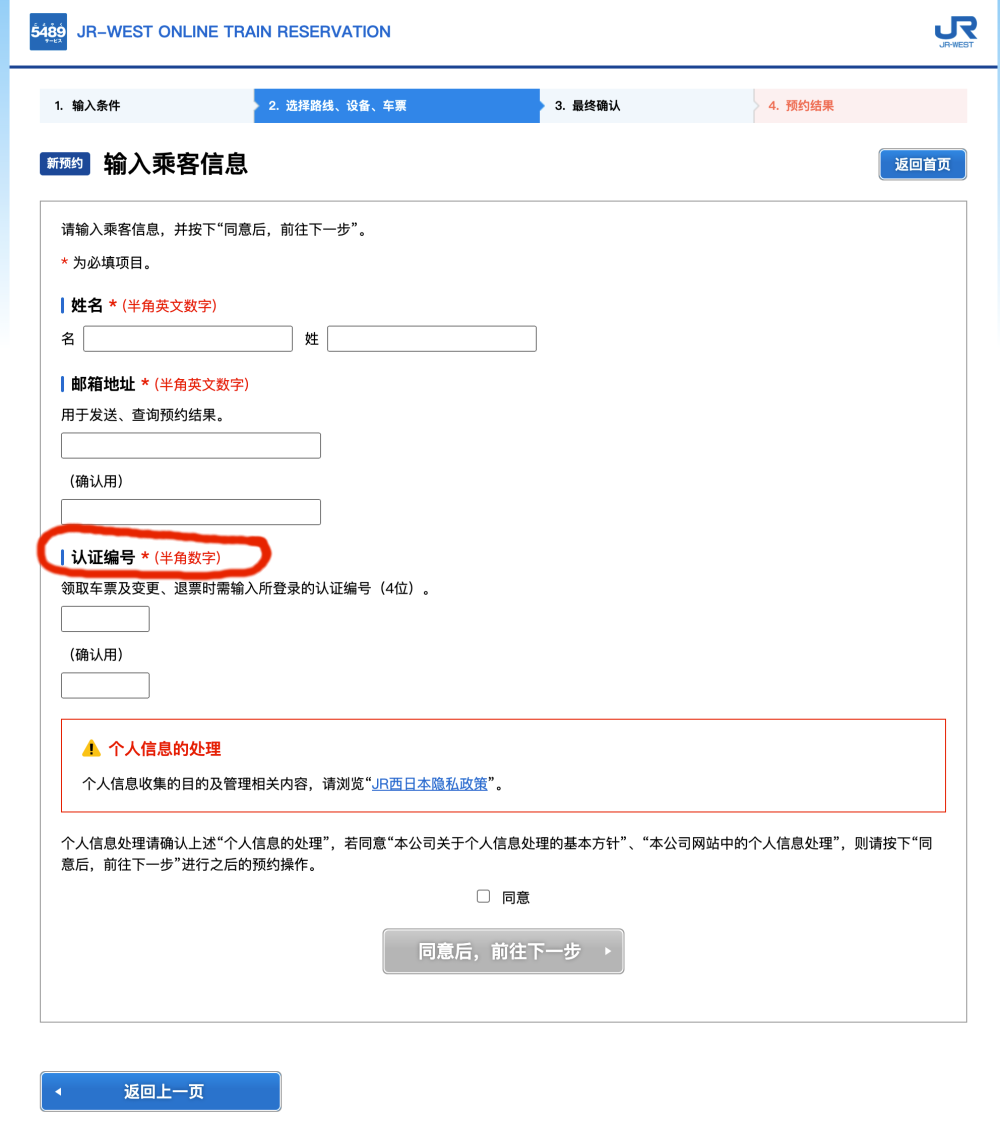
Remember the ‘Authentication Number’ when ordering the pass
Follow the website’s steps, fill in the required information, and pay online using a credit card. After arriving in Japan, you’ll need the same credit card used for the online payment to pick up the tickets from a JR Green Ticket Vending Machine. Important: If your credit card only has a magnetic stripe and no chip (IC chip), the vending machine cannot read it. In this case, you must go to a staffed JR Ticket Office (Midori no Madoguchi) to collect your tickets.
Waiting times at the JR Ticket Office counters can be long, so I personally recommend using the vending machines if possible.
Within its validity period, the “Kansai Area Pass” allows two rides on the “Kansai-Airport Express HARUKA.” You can also use it to reserve seats on the HARUKA (similar to assigned seating on trains in China). When collecting your pass at the Green Ticket Vending Machine, first complete the pass collection process. Then, re-insert the collected “Kansai Area Pass” into the machine to make your HARUKA reserved seat selections.
The “Kansai Area Pass” comes with 3 vouchers for the “Kyoto Municipal Subway,” “Keihan Electric Railway,” and “Hankyu Railway.” Within the validity period of your Kansai Area Pass, you can exchange each voucher for a one-day pass on the respective railway/subway system. These three one-day passes can be exchanged and used on different dates.
Example: You purchased a 4-day Kansai Area Pass.
Day 1: Arrive at Kansai International Airport (KIX) in Osaka. Collect the pass. Exchange for a reserved seat on the HARUKA from KIX to Kyoto. Travel from Osaka to Kyoto that day.
Day 2: Exchange one voucher for a “Kyoto Municipal Subway” one-day pass. Use the subway as much as possible for sightseeing in Kyoto.
Day 3: Exchange the remaining vouchers for “Keihan Electric Railway” and “Hankyu Railway” one-day passes. Utilize these railways for your travels in Kyoto.
HARUKA One-Way Ticket
If your plan is to travel from Kansai International Airport directly to Osaka city, Kyoto, Kobe, or Nara upon arrival, and you don’t plan extensive JR travel on subsequent days, purchasing a “HARUKA One-Way Ticket” might be a better choice.

HARUKA One-Way Ticket
You can book the “HARUKA One-Way Ticket” yourself on the “JR West Official Website” (Booking Page ). After arriving at KIX, pick up your ticket at a JR Ticket Office or a Green Ticket Vending Machine. The collection process and reserved seat selection are the same as for the “Kansai Area Pass.”
HARUKA One-Way Ticket Fares and Destinations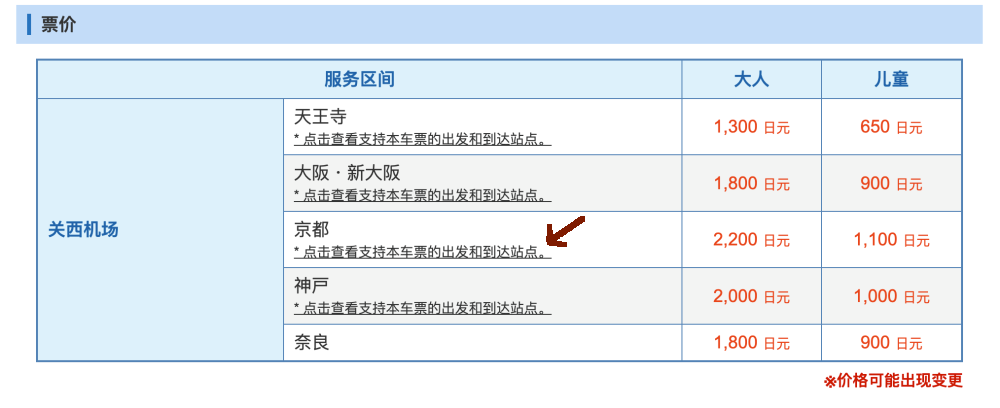
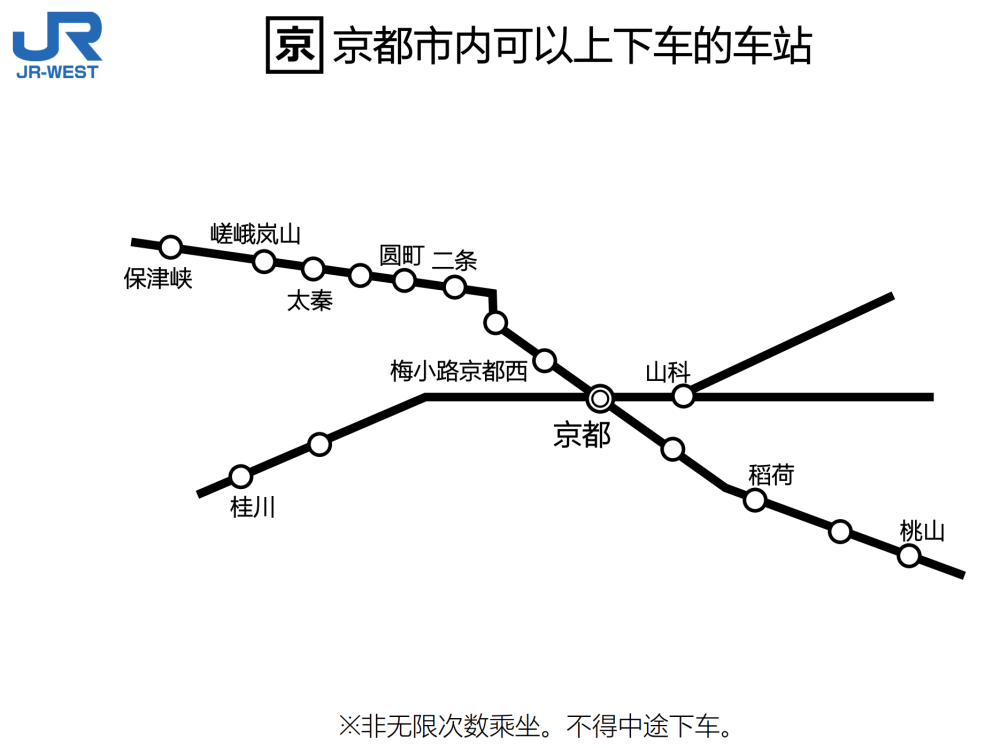
HARUKA One-Way Ticket - Reachable Stations in Kyoto Area
Using Kyoto as an example: If you buy a ticket from KIX to Kyoto, you can arrive at JR Kyoto Station, stay within the ticket gates, and transfer for free to another JR line to stations like “JR Nijo” or “JR Saga-Arashiyama.”
JR Kansai Mini Pass
JR Kansai Mini Pass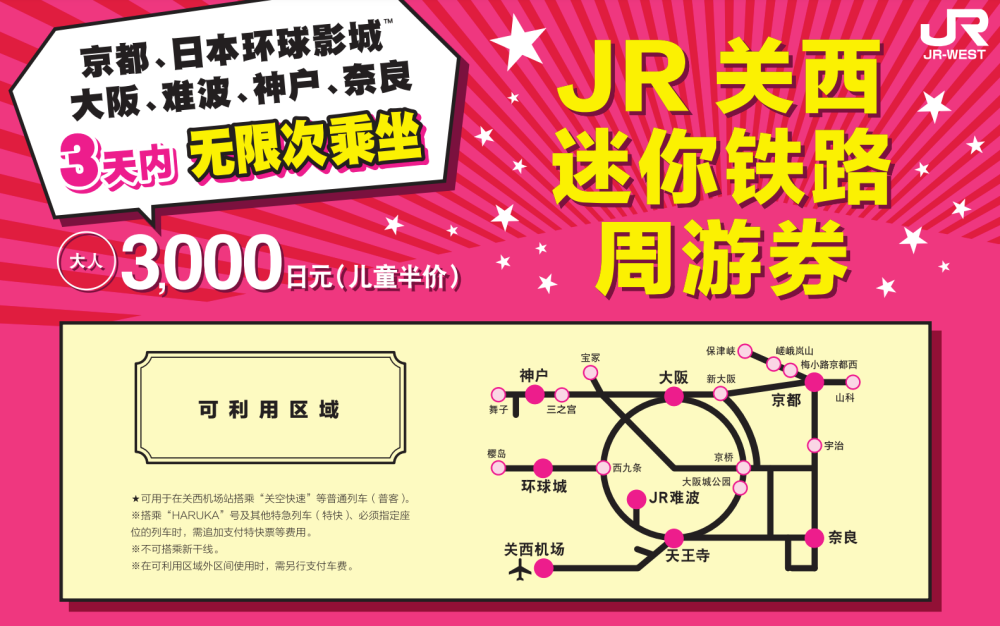
| Kansai Area Pass | JR Kansai Mini Pass | |
|---|---|---|
| Validity Period | Select 1-4 days at purchase | Fixed 3 consecutive days |
| Purchase Method | JR West website or travel agency | Overseas travel agency only |
| Price | ¥2,800 - ¥7,000 (for 1-4 days) | Fixed ¥3,000 (for 3 days) |
| Coverage Area | Osaka, Kyoto, Nara, Uji, Kobe, Wakayama, Himeji | Osaka, Kyoto, Nara, Uji, Kobe |
| Other Bonuses | Vouchers for Kyoto Subway, Keihan, Hankyu (1 day each) | None |
| Usable Transport | JR trains, JR buses | JR trains only |
The “JR Kansai Mini Pass” cannot be purchased directly from the JR website by individuals. It must be bought through an authorized travel agency outside Japan. When purchasing, you don’t need to specify the usage dates or link it to a passport. Only when you exchange the voucher for the actual pass at a JR Ticket Office or Green Ticket Vending Machine in Japan will you need to bind each pass to a specific passport and designate the starting date of use.
Sagano Scenic Railway (嵯峨野観光鉄道)
The Sagano Scenic Railway is a tourist train popular for sightseeing in the Arashiyama area of Kyoto, especially beautiful during cherry blossom season in spring and autumn foliage season.

Sagano Scenic Railway
Car No. 5 (the “Rich” car) of the train is an open-air carriage without glass windows, offering excellent views in good weather. However, seats might get wet if it rains. If you want tickets for Car No. 5, you usually need to request them specifically when buying tickets in person. When booking online via the JR West system, you might need to select the specific option often labelled [Sagano Rich].
The Sagano Scenic Railway sells both reserved seat tickets and standing tickets. You can check Sagano Scenic Railway Seat Availability . If reserved seats for your desired date are sold out online, you might still be able to purchase standing tickets on the day of travel at the station. However, during peak times, even standing tickets might sell out.
To purchase tickets online, you can start from the Sagano Scenic Railway website and click “Reserve Now.” Follow the steps, which will eventually lead you back to the JR West reservation system for the actual booking.
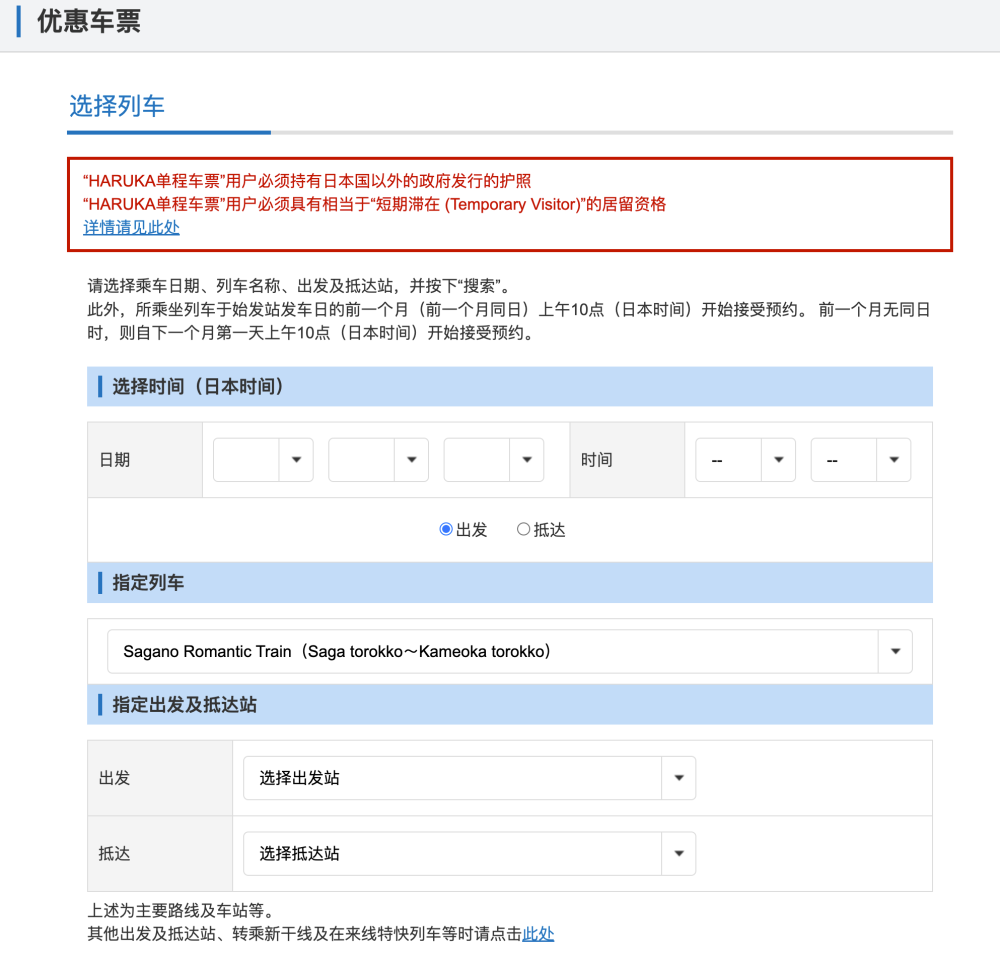
Sagano Scenic Railway - Reservation Page
Interestingly, on the booking page, the train is listed as “Sagano Romantic Train,” only in English, while the departure and arrival station options below might show Chinese characters alongside English/Japanese.
Tickets purchased online (pre-booked) can only be collected at JR West ticket offices (Midori no Madoguchi). They cannot be picked up at JR Tokai, JR East, JR Shikoku, or JR Kyushu ticket offices, nor at travel agencies or Sagano Scenic Railway’s own station ticket counters.
Based on our personal experience riding the train, excluding Car No. 5, standing tickets in the other carriages offer more freedom of movement when not crowded, and the views along the route are still quite good.
Kansai Region City Transit Passes: Subway & Bus One-Day Tickets
Kyoto Subway & Bus One-Day Pass
Many tourist cities in Japan offer one-day or multi-day transportation passes. Based on our itinerary needs, we purchased the “Kyoto Subway & Bus One-Day Pass” on our first day in Kyoto.
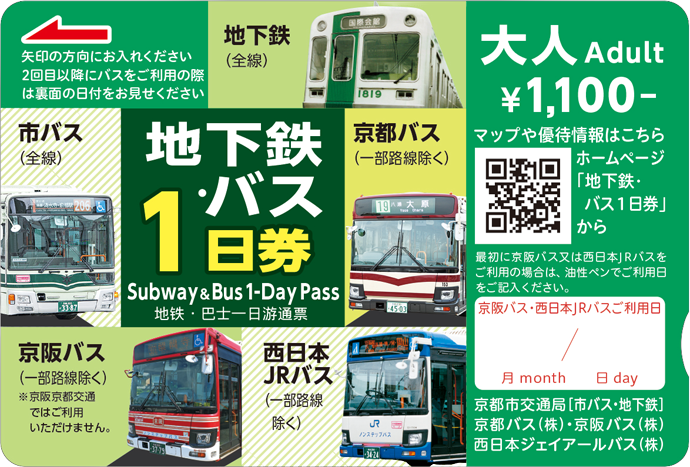
Kyoto Subway & Bus One-Day Pass
The “Kyoto Subway & Bus One-Day Pass” costs ¥1,100 for adults. It allows unlimited rides within a single day on Kyoto Municipal Subway lines, Kyoto City Buses, Kyoto Bus (most routes), Keihan Bus (some routes), and West Japan JR Bus (some routes). You can find more information on this website .
We had an interesting experience buying the pass at Kyoto Subway’s Nijo-jo Mae Station. After entering the subway station area, there was no staff visible at the service window next to the ticket gates. A small sign indicated to press a button for assistance. Upon pressing it, a Japanese greeting came through the speaker. Since our Japanese is minimal, we showed a screenshot of the one-day pass (saved from the website) to the camera. Soon, someone appeared at the window and asked how many tickets we needed. Remember to ask for a paper map (“chizu” - 地図) when you purchase the ticket; it’s useful for navigation and makes a nice souvenir.
The “Kyoto Subway & Bus One-Day Pass” covers unlimited rides on buses within a specific fare zone. Travel outside this zone requires paying a supplementary fare. You can check the valid area on the Kyoto Subway & Bus Route Map .

Kyoto Subway & Bus One-Day Pass - Fare Zone Example
As shown in the map example above, on that day we first took a bus to Sanzen-in Temple (top right on the map). Since Sanzen-in is within the yellow zone, the ride was covered by the pass. Later, when we traveled towards Kibune Shrine (via Kibuneguchi Station, top left on the map), we went beyond the yellow boundary. Travel past the “Ichihara” stop required paying an additional fare difference.
Using the Kyoto Subway & Bus One-Day Pass:
- Subway: Insert the pass into the ticket gate slot when entering, and retrieve it after passing through. Repeat when exiting.
- Bus (First Use):
- For buses with variable fares (based on distance): Board through the rear door. Insert the pass into the card reader near the door.
- For flat-fare buses: No action needed upon boarding.
- When exiting from the front door, insert the pass into the card slot near the driver. For variable fare buses, the machine calculates if extra fare is due (payable with cash or IC card). This first insertion prints the current date onto the pass.
- Bus (Subsequent Uses): On all subsequent bus rides that day, simply show the back of the pass (with the printed date) to the driver when exiting.
Nara Bus One-Day Pass
We also visited Nara during this autumn trip. We walked from JR Nara Station to Todai-ji Temple. From Todai-ji, we took a bus to Toshodai-ji Temple, and then another bus from Toshodai-ji back to JR Nara Station. Each of these bus rides cost ¥270 one-way.
If you plan to visit more attractions in Nara requiring bus travel, one-day passes are also available. You can find information about these passes on the Nara Kotsu Bus Lines website .
The previous article described our 8-day itinerary in Japan’s Kansai region during the autumn foliage season, along with the research and use of various transportation discount passes. This article detailed the types of JR trains, several relevant passes we considered, and city-specific passes like the Kyoto Subway & Bus One-Day Pass. In the next article, I will share more specific tips we discovered for train travel, details about the areas around our hotels, and some food recommendations I found worthwhile.